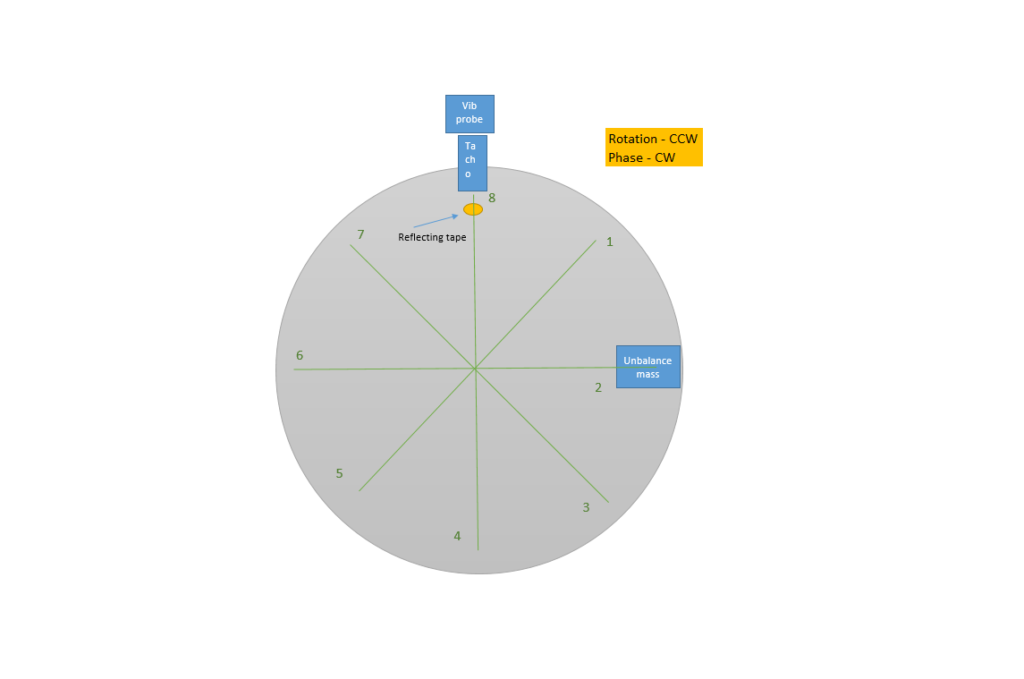There are lot of confusions roaming around “High spot” and its relationship with vibration vectors (D-V-A). The purpose of this article is to shed some
light on this topic. The image shown below will be referred throughout this text.
Relationship between Heavy Spot, High spot and Vibration vectors

Many don’t have any second opinion about Heavy spot – It is the angular location of mass unbalance. In the above figure, the location of heavy spot is 90 deg from shaft speed reference (reflecting tape, for example). This is where the mass will be removed during balancing process. In the above image, Blade no 2 is the Heavy spot. This is 90 deg from shaft speed reference mark.
The angular location opposite Heavy spot is the “Light spot”. Balancing weight should be added in this location during balancing process. In the above image, Blade no 6 is the Light spot. This is at 270 deg from shaft speed reference mark.
What is “High Spot”? Is it an indication of a location in the rotor? or just indication vibration vectors like amplitude and phase of D-V-A? Will “High spot” ever lead “Heavy spot” in actual rotating machinery?
To understand this, We should understand the definition of High spot.
“High spot is a measure of response. It is the angular location of the shaft that moves closer to (any) vibration transducer.”
As like heavy spot or light spot, High spot is also an indication of a location in the rotor. For an equipment having only 1X vibration, there is only one location of the shaft that will move closer to the transducer, which is the high spot.
Let’s consider that the above rotor is running well below first critical speed with negligible damping. Due to the centrifugal force, the heavy spot will drive the rotor out from centerline. The shaft position relative to blade no 2 will move closer to the transducer. This is the location of High spot and this is same as Heavy spot. The angular location of the High spot is 90 deg from shaft speed reference mark.
This is the reason why we normally get to see the statement in texts “Below first critical, Both High spot and Heavy spot are in same angular location”.
(Depending on damping, High spot will lag heavy spot between 0 to 90 deg when running well below first critical speed itself. But, Let’s keep our
discussion with only with undamped system here).
Due to the dynamics of the system, the high spot will start to lag the heavy spot when the rotor moves closer to the first critical speed (or balance
resonance speed). For any undamped / underdamped / critically damped system, High spot will exactly lag Heavy spot by 90 deg.
And the lag will further be up to 180 deg well above critical.
The phase lag could be mathematically calculated using the below formula:
Ѳ = tan-1(2£ (ω/ ωn) / (1-(ω/ ωn)2)
This means that the High spot always lags the Heavy spot. It will never lead. In other words, If there is no force, there will be no response.
Now, How can this High spot be related to Displacement, Velocity and Acceleration vectors.
Phase angle is the time difference between Shaft speed references (reflecting tape) to the first positive peak in the time waveform.
In the above figure, the maximum displacement will be observed when blade 2 reaches 12 o clock position where the transducer is located. The phase difference between the shaft speed references to maximum displacement (blade 2) is 90 deg. Here, the concept of High spot and displacement are matching. Both measures the angular location of the shaft that moves closer to the transducer.
What about Velocity and Acceleration?
Maximum velocity by a vertically mounted transducer will be measured when the heavy spot is in equilibrium position (Exactly at the same moment
indicated in the image). Now shaft speed reference is also near tachometer. Hence the Velocity vector phase angle is Zero degree. (This is matching with our theory of Velocity leading displacement by 90 deg.)
Does this mean that the High spot is Zero deg when measured in velocity units? No, because the shaft is not closer to the transducer – It will
reach closer to the transducer after quarter of a cycle – 90 deg – the phase angle of displacement.
Same concept applies to Acceleration as well. The shaft would be having maximum displacement in the negative direction when acceleration is at peak (recall the pendulum concept). The phase angle of acceleration is 270 deg. This can also not be called as High spot as the shaft will be far away from transducer.
In this case, the high spot is at 90 deg and displacement phase angle is also 90 deg. Hence, Displacement is naturally known for direct
indication of High spot. The relationship remains same at and above critical speed as well.
Hence the phase angle of Displacement is a true measure of High spot in the rotor. The angular location indicated by displacement (90 deg in this case) will exactly mark the high spot on the rotor when both Vibration and Tachometer are in same location. If the vibration sensor and tachometer are in different angular location, then the angular location of vibration transducer with respect to tachometer should be added to the measured phase angle of displacement to locate the High spot.
References:
2. “Advanced field balancing techniques” by Ray Kelm
3. Basic Machinery Vibrations by Ronald Eshleman
